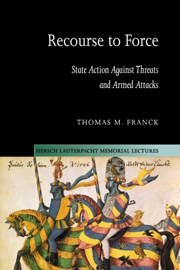Book contents
- Frontmatter
- Contents
- Acknowledgments
- 1 The United Nations' capacity for adapting to radical changes of circumstance
- 2 Use of force by the United Nations
- 3 The original parameters of self-defense
- 4 Self-defence against state-sponsored terrorists and infiltrators
- 5 Self-defense against ideological subversion
- 6 Self-defense against attacks on citizens abroad
- 7 Anticipatory self-defense
- 8 Countermeasures and self-help
- 9 The “purely humanitarian” intervention
- 10 What, eat the cabin boy? Uses of force that are illegal but justifiable
- Index
3 - The original parameters of self-defense
Published online by Cambridge University Press: 17 July 2009
- Frontmatter
- Contents
- Acknowledgments
- 1 The United Nations' capacity for adapting to radical changes of circumstance
- 2 Use of force by the United Nations
- 3 The original parameters of self-defense
- 4 Self-defence against state-sponsored terrorists and infiltrators
- 5 Self-defense against ideological subversion
- 6 Self-defense against attacks on citizens abroad
- 7 Anticipatory self-defense
- 8 Countermeasures and self-help
- 9 The “purely humanitarian” intervention
- 10 What, eat the cabin boy? Uses of force that are illegal but justifiable
- Index
Summary
We have considered the Charter's primary thrust: the prohibition of aggression and enforcement of that ban by collective military measures taken in the name of the new Organization. Only as a secondary, fail-safe resort did the drafters permit members to deploy force in their individual, sovereign capacity, and then only in self-defense against an actual armed attack. Under pressure of changing circumstances, however, this exception to the general prohibition on nations' unilateral recourse to force has also undergone adaption and expansion through institutional practice.
Self-defense: the drafting history
A euphoric tone was set at the San Francisco Conference by the imminence of Allied victory over the Axis. Participants knew that this had been achieved primarily by the effort of the Big Powers. Presented with a draft prepared by those nations' leaders and diplomats, representatives of less-powerful states were little inclined to challenge its fundamentals. They appreciated that no organization for the preservation of peace could succeed unless the principal Powers were willing participants and they realized that such participation had a price.
On the other hand, lesser states had also sacrificed: some had been occupied as a result of failure of the League of Nations, others had voluntarily joined the Allied cause. All had suffered. Understandably, there was some doubt at San Francisco as to whether the new system would really afford better protection than had the Covenant.
- Type
- Chapter
- Information
- Recourse to ForceState Action against Threats and Armed Attacks, pp. 45 - 52Publisher: Cambridge University PressPrint publication year: 2002



